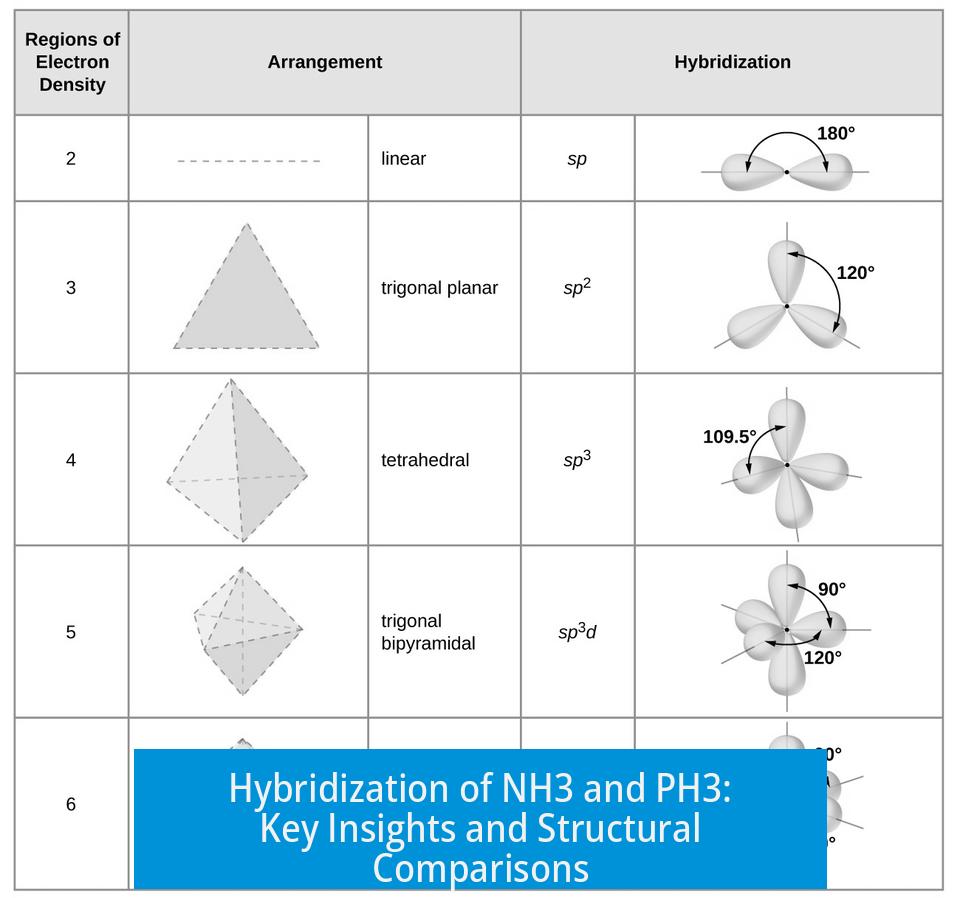Hybridization of NH3 and PH3
The difference in hybridization between NH3 (ammonia) and PH3 (phosphine) stems mainly from the inert pair effect, which influences the participation of s orbitals in bonding. NH3 exhibits strong sp3 hybridization, while PH3 behaves as if bonding involves largely unhybridized p orbitals.
Inert Pair Effect and Orbital Energy Gap
Nitrogen in NH3 has a relatively small energy gap between its 2s and 2p orbitals. This small gap allows these orbitals to hybridize into sp3 orbitals, mixing one s and three p orbitals. The hybridization leads to a tetrahedral electronic geometry with one position occupied by a lone pair, causing bond angles near 107°.
Phosphorus in PH3, in contrast, exhibits the inert pair effect. The energy gap between the 3s and 3p orbitals is much larger. The 3s orbital remains non-bonding and low in energy, effectively inert. As a result, phosphorus bonds using mostly unhybridized 3p orbitals. This leads to bond angles close to 90°, typical for bonds formed by pure p orbitals.
Structural Similarities and Lone Pair Influence
Both NH3 and PH3 have trigonal pyramidal molecular geometries due to three bonding pairs and one lone pair on the central atom. The lone pair repels the bonding pairs, depressing bond angles from the perfect tetrahedral angle.
However, PH3’s larger atomic radius means its lone pair is more diffuse. Thus, it exerts a stronger repulsive effect but the bonding orbitals remain mostly p in character. NH3’s lone pair is more localized due to nitrogen’s smaller size and higher electronegativity, making the molecule’s base stronger and bond angles narrower.
Effect on Bond Angles and Base Strength
- NH3 has bond angles near 107°, reflecting strong sp3 hybridization.
- PH3 has bond angles close to 90°, consistent with unhybridized p orbitals bonding.
- NH3 is a stronger base since its lone pair is in an sp3 orbital, more accessible for protonation.
- PH3’s lone pair is less available due to its diffuse orbital and lower electronegativity.
Energetic and Spatial Considerations
Nitrogen’s smaller size produces more covalent character in N–H bonds. The H atoms crowd closer, increasing repulsion among their partial positive charges. Hybridization balances these interactions efficiently. Phosphorus, being larger, keeps hydrogens further apart with less need for hybridization.
The energy cost of hybridization is lower for nitrogen, favoring bonding in hybrid orbitals. For phosphorus, the cost outweighs the benefit, so it retains mostly unhybridized orbitals for bonding.
Key Takeaways
- NH3 shows clear sp3 hybridization with ~107° bond angles and a strong lone pair.
- PH3 tends to bond with mostly unhybridized p orbitals, producing ~90° bond angles.
- The inert pair effect causes phosphorus’s 3s electrons to remain non-bonding.
- Lone pair localization and electronegativity differences influence base strength.
- Structural pyramidal shape in both molecules arises from lone pair repulsion.
Why does NH3 exhibit sp3 hybridization while PH3 does not fully hybridize its orbitals?
NH3 forms sp3 hybrids because nitrogen’s s and p orbitals have a small energy gap. Phosphorus has a larger gap due to the inert pair effect, so its s orbital remains mostly unhybridized in PH3.
How do bond angles in NH3 and PH3 differ and why?
NH3 has bond angles around 107°, reflecting sp3 hybridization. PH3 shows bond angles near 90° because hydrogen bonds involve unhybridized p orbitals, resulting from phosphorus’s larger size and orbital energy differences.
Do NH3 and PH3 both have pyramidal structures and why?
Yes, both have pyramidal shapes due to lone pairs pushing hydrogen atoms downward. The effect is stronger in PH3 because phosphorus is larger and its electron cloud more diffuse, affecting the repulsion forces.
Why is ammonia a stronger base than phosphine?
Ammonia’s nitrogen holds its lone pair more tightly because of higher electronegativity and smaller size, making it more available for bonding. Phosphorus’s lone pair is less available due to its diffuse electron cloud.
How does atomic size influence hybridization and bonding in NH3 and PH3?
Nitrogen’s smaller size causes closer hydrogen atoms and promotes sp3 hybridization. Phosphorus, being larger, keeps hydrogens further apart and favors bonding through unhybridized p orbitals, conserving energy.





Leave a Comment